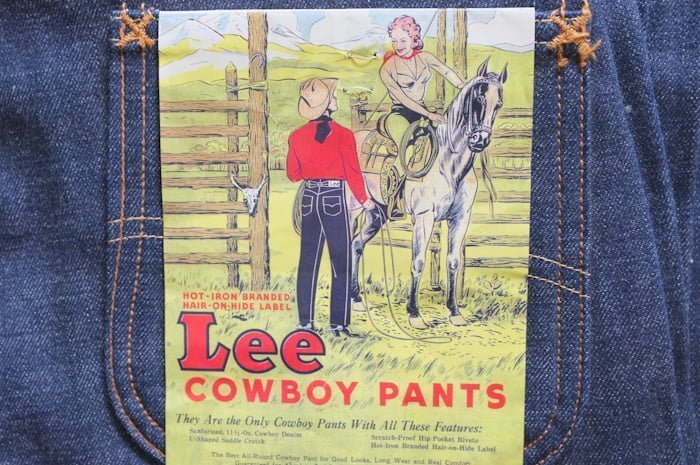Pada tahun 1936 Lee mengeluarkan salah satu produk 101B yang ikonik yang dipasarkan dengan fitur Hair-on-hide patch, dimana patch di bagian belakang celana masih memiliki rambut. Kami berkesempatan untuk meraba dan mereview produk yang cukup ikonik ini yaitu Lee 101B 1936 model yang diproduksi oleh Edwin Japan dan merupakan dry jeans. Walaupun memiliki fitur patch yang unik, produk ini memiliki kemiripan dengan produk pendahulunya yaitu model 1930 khususnya dalam hal cutting dan detail vintage.
Perbedaan yang paling mencolok dengan model pendahulunya adalah penggunaan warna benang jahit yang berbeda. Model 1930 memiliki warna benang orange kemerahan yang mencolok sementara model 1936 menggunakan warna benang orange tembaga yang lebih umum digunakan. Model 1936 masih memiliki sebuah cinchback di belakang dan masih memiliki fitur triple stitch di yoke dan seam. Begitu pula dengan 2 jahitan rantai yang digunakan di bagian bawah waistband.



Tentunya hal yang paling menarik dari model ini adalah leather patchnya yang menggunakan salah satu ciri khas Lee yaitu Hair-on-hide. Pada patch semacam ini, pada kulitnya masih disisakan rambut atau bulunya, lalu di cap dengan logo Lee. Patch pada model ini mengalami perpindahan tempat dimana pada model 1930 patchnya terletak di sebelah kiri, sementara di model ini sudah dipindahkan ke bagian kanan waistband. Uniknya, patch ini akan berbeda-beda tiap jeans karena satu lembar kulit yang dipakai akan memiliki warna dan tekstur rambut yang berbeda.


Model ini sudah tidak lagi menggunakan suspender button yang terdapat di model 1930. Top button yang digunakan juga berbeda, yaitu berwarna kekuningan dengan tulisan Union Made. Button untuk button flynya menggunakan donut button dengan lubang di tengahnya.



Jeans ini memiliki cinchback yang direkatkan dengan 2 buah rivet di kedua ujungnya yang digunakan untuk mengecilkan ukuran pinggang jika ternyata kebesaran. Seperti ciri khas Lee, pada model ini juga tentunya memiliki label di bagian dalam waistband. Label ini sudah berganti desainnya menjadi berwarna latar hitam dengan logo Lee berwarna kuning dan tulisan merah lainnya. Berbeda dengan model sebelumnya, label ini sudah ditempatkan di bagian tengah waistband dan sepertinya akan terus ditaruh di tengah untuk model-model selanjutnya.



Untuk memperkuat bagian crotch, Lee seperti biasa memakaikan rivet pada crotchnya dan juga terdapat di produk ini. Seperti kebanyakan produk Lee lainnya, inseam jeans ini dibuat dengan double felled seam dan outseamnya dengan open seam sehingga selvage line yang cukup unik (natural dan black line) terlihat di bagian luar seam. Konstruksi hemnya sama seperti model 1930 yang memulai jahitan dari bagian inseam lalu ke outseam.



Jika kita lihat dari selvage line dan tekstur keseluruhannya, kita bisa menyimpulkan bahwa bahan yang dipakai adalah bahan yang sama dengan model 1930 yaitu indigo denim dengan berat 11,5 oz yang memiliki tekstur yang cukup coarse dan cukup tidak teratur walaupun setelah diraba, bahan ini memiliki permukaan yang sangat halus. Warna yang ditawarkan denim ini merupakan warna yang menurut kami cukup vintage, tidak terlalu gelap dan warna birunya halus.



PS: Bahas juga produk ini dan produk-produk Lee lainnya di forum
———————————————————————————————————
In 1936 Lee introduced one of the most iconic features on 101B which is Hair-on-hide patch. We have the chance to review this pretty unique product with Hair-on-hide patch which is Lee 101B 1936 model, produced by the renown Edwin Japan. Even with this unique Hair-on-hide patch, this jeans still got their resemblance to the previous 1930 model in term of cutting and vintage details.
The most visible difference is the use of the thread, which in this product use a more traditional and widely used coppery orange color, whereas in the previous model, reddish orange color thread is used. This 1936 model still used a cinchback at the back and still got that triple stitch feature on yoke and seam. They still got the 2 chainstitch seam in the lower part of the waistband as well.
The most interesting part from this model is obviously the leather patch. The leather patch use on of the most iconic Lee features which is Hair-on-hide patch. In this kind of patch, hair from the raw hide is still there and preserved and then branded with a hot iron brand with Lee logo. This patch also moves to the right part of the waistband compared to the previous model which has the patch on the left side. The patch will be unique on every product because the texture and color of the hair from one sheet of hide is different in some parts.
This model doesn’t use suspender buttons anymore and use a beltloop with different color thread instead. The top button used is also different. This button has a yellowish copper color with Union Made writings on it. Donut buttons are used for the button fly.
The jeans also have a cinchback fastened with 2 rivets at both ends, to adjust the waist size. One of Lee characteristic is putting a label on their inner waistband, and on this product, the label design has changed to a black background with yellow gold embroidery. The label is also put in the center, different from the previous model.
To reinforce the crotch, Lee as usual use rivet on that part. Like most of Lee product, this model also use double felled seam for the inseam and open seam for the outseam, that way the selvage line is exposed on the outerseam. The hem construction is similar to the 1930 model, in which the stitching routine seems to start from the inseam all the way to the outseam.
We seen the fabric and selvage line and we can conclude that the fabric used for this model is similar and maybe the exact one used for the 1930 model which is made from an 11,5oz indigo denim with a coarse and pretty irregular textures. Upon closer inspection and touching, this fabric seems to have that smoothness you can expect from sanforized fabrics. The color that this denim offered is, in our opinion, quite vintage, which are not too dark with the delicate blue color.
PS: you can also discuss more about Lee’s product at the forum